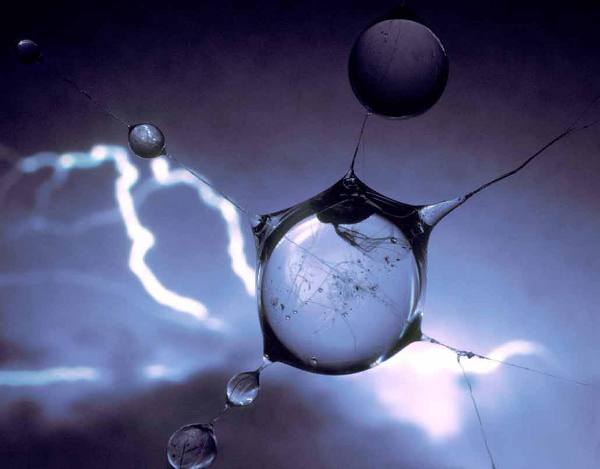Living Data
Big Picture Story 04:
Weather making and climate control
Green Life (Microscopic Algae) had become so numerous in the Primaeval Ocean that by at least 2.5 billion years ago, as part of the evolving Biosphere, biological weather making and climate control were operating - as they still do today in the oceans. Algal blooms - the massive multiplication of microscopic green cells on vast areas of ocean - have a short life. When they die, they rot and produce rotten egg gas (dimethyl sulphide) that rises into the atmosphere with the water vapour of evapouration. It contains microscopic particles of sulphur. These act as nuclei for droplet formation and thus for cloud formation. Clouds have a valuable role in temperature control, reflecting heat back into space (as do ice and snow) - the albedo effect. The clouds that are generated over the oceans travel on the wind currents made by the spinning of the Earth, and take rain away to distant places, as well as more locally.
Within the time that Life-as-we-know-it has been around (only in the last 600 million years) continuing evolution of Terrestrial Life resulted in another green (PLANT-based) mechanism for biological weather-making and climate control. With the arrival of Flowering Plants in the last 150 million years and of dense forests of broad-leaved trees globally in the last 100 m.y., in particular, an albedo producing mechanism developed. In this, transpiring vegetation that was releasing vast volumes of water vapour into the atmosphere has been found to have been releasing bacteria (Aerobacter) in similar volume, and each microscopic bacterium has been acting as a nucleus for droplet and cloud formation. (This new research involving Aerobacteris ongoing and not yet fully documented, but is another wonderful example of complex mechanisms in our symbiotic Biosphere.)
Dr Mary E. White 2012

Lorraine Beaulieu. Atmospheric chronicle Cyanotype prints on fabric. 2008
With her installation, Lorraine Beaulieu propose a work of art with an ecological subject matter where she uses an object which can be recognised in every cultue to reflect on global warming. An umbrella is an accessory used for protection against bad weather, against rain or a storm. It is an extension of a person's body to shelter oneself from adverse climate. Using many different motifs of vegetables and human silhouettes, she prints by means of the cyanotype process on emuslion on cancas, in some way remembering images of what should be preserved. The imbrellas are on their own, without their owners mankind be able to invent another "umbrella" to shelter itself from future catastrophes?
Andrea Juan, artist

Paul Sutton. After the Rain Photograph. 2012
Until now, I had not really thought of my After the Rain work as being part of the Big Picture of climate change. I came to a realisation about 12 months ago that the stronger photographs in my recent work were made after the rain. Then, I consciously commenced work on this project. I suppose everything relates to climate change in some way.
Paul Sutton. 2012
Tom FrazerThe boy who loved the rain
Animation 2005
The boy who loved the rain visualises our connection to water and the dire consequences of ceasing to care about it. The animation was written, directed and animated in 2005 by Tom Fraser as a student at the Victorian College of the Arts in Melbourne, Australia. He used an under camera animation technique of painting on glass. The fluidity of the paint, choreography and editing visualise the flowing nature of water and appeal to body knowledge of it. Rain is part of the weather making process that connects us to other living systems. Most of the global living system is water. We glean knowledge from our bodily senses and our minds, and such devices as satellite systems and televisions. But how do we make sense of all the data that comes our way? Does how we think aout things align with our feelings of connection to them? As the animation shows, losing connection to the environment is dangerous.
Claire BeynonLove the waters
Animation 2011
Love The Waters is a lyrical film celebrating the beauty and fragility of our world's oceans and making a subtle call to right relationship with our natural environment. "Aristotle said 'Philosophy begins in wonder.' I believe it also ends in wonder. The ultimate way we relate to the world as something sacred is by renewing our sense of wonder.' (Sam Keen) Directed, produced and narrated by Claire Beynon with a collaborative text by international writers.
Claire Beynon on Vimeo October 2011
Boats and flying creatures appear in dreams and art. Their forms and movement qualities are circling, spiralling and crossing. The circle holds within it data that resulted from Claire's collaboration with scientist Sam Bowser:
Interface 1and Interface 11?
References
It has recently been discovered that bacteria play a major role in the birth of dense, reflective, rain-bearing clouds. Each of the enlarged droplets that form these clouds requires a nucleus on which water vapour can condense and accumulate. The land supplies these nuclei in the form of dust as well as the bacteria that escape from green leaves via their breathing pores. Such bacteria form a major component in the mass of organisms that drift about the planet as aerial plankton. The sea also provides nuclei for clouds in the form of a vapour that is discharged by a broad range of photosynthetic marine plankton. This vapour, a by- product of marine bacteria, is dimethyl sulfide (DMS). Where dust, pollen, DMS and aerial plankton fail to supply sufficient nuclei for raindrops to form, clouds may still appear, but rain rarely falls. (Walter Jehne, Nature and Society, Jan. 2007 pp.7-14.)

A dead midge and a strand of crumpled spider silk provided the nucleus about which this large droplet coalesced. It epitomises the nucleation process that is midwife to the growth of the dense clouds that form the planet's life-giving rain storms and maintains its highly reflective cloud cover. The dense white cumulous clouds that deliver much of the planet's rain also reflect up to 80% of the incoming sunlight and help to cool the planet.
Text and image Reg Morrison, 2012











